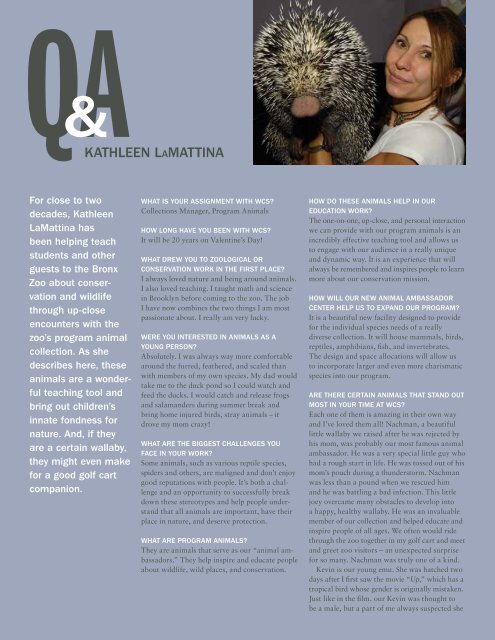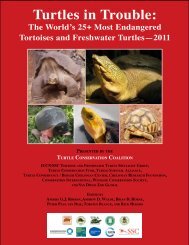WCS Annual Report 2012 - Wildlife Conservation Society
WCS Annual Report 2012 - Wildlife Conservation Society
WCS Annual Report 2012 - Wildlife Conservation Society
Create successful ePaper yourself
Turn your PDF publications into a flip-book with our unique Google optimized e-Paper software.
Kathleen LaMattina<br />
For close to two<br />
decades, Kathleen<br />
LaMattina has<br />
been helping teach<br />
students and other<br />
guests to the Bronx<br />
Zoo about conservation<br />
and wildlife<br />
through up-close<br />
encounters with the<br />
zoo’s program animal<br />
collection. As she<br />
describes here, these<br />
animals are a wonderful<br />
teaching tool and<br />
bring out children’s<br />
innate fondness for<br />
nature. And, if they<br />
are a certain wallaby,<br />
they might even make<br />
for a good golf cart<br />
companion.<br />
What is your assignment with <strong>WCS</strong>?<br />
Collections Manager, Program Animals<br />
How long have you been with <strong>WCS</strong>?<br />
It will be 20 years on Valentine’s Day!<br />
What drew you to zoological or<br />
conservation work in the first place?<br />
I always loved nature and being around animals.<br />
I also loved teaching. I taught math and science<br />
in Brooklyn before coming to the zoo. The job<br />
I have now combines the two things I am most<br />
passionate about. I really am very lucky.<br />
Were you interested in animals as a<br />
young person?<br />
Absolutely. I was always way more comfortable<br />
around the furred, feathered, and scaled than<br />
with members of my own species. My dad would<br />
take me to the duck pond so I could watch and<br />
feed the ducks. I would catch and release frogs<br />
and salamanders during summer break and<br />
bring home injured birds, stray animals – it<br />
drove my mom crazy!<br />
What are the biggest challenges you<br />
face in your work?<br />
Some animals, such as various reptile species,<br />
spiders and others, are maligned and don’t enjoy<br />
good reputations with people. It’s both a challenge<br />
and an opportunity to successfully break<br />
down these stereotypes and help people understand<br />
that all animals are important, have their<br />
place in nature, and deserve protection.<br />
What are program animals?<br />
They are animals that serve as our “animal ambassadors.”<br />
They help inspire and educate people<br />
about wildlife, wild places, and conservation.<br />
How do these animals help in our<br />
education work?<br />
The one-on-one, up-close, and personal interaction<br />
we can provide with our program animals is an<br />
incredibly effective teaching tool and allows us<br />
to engage with our audience in a really unique<br />
and dynamic way. It is an experience that will<br />
always be remembered and inspires people to learn<br />
more about our conservation mission.<br />
How will our new Animal Ambassador<br />
Center help us to expand our program?<br />
It is a beautiful new facility designed to provide<br />
for the individual species needs of a really<br />
diverse collection. It will house mammals, birds,<br />
reptiles, amphibians, fish, and invertebrates.<br />
The design and space allocations will allow us<br />
to incorporate larger and even more charismatic<br />
species into our program.<br />
Are there certain animals that stand out<br />
most in your time at <strong>WCS</strong>?<br />
Each one of them is amazing in their own way<br />
and I’ve loved them all! Nachman, a beautiful<br />
little wallaby we raised after he was rejected by<br />
his mom, was probably our most famous animal<br />
ambassador. He was a very special little guy who<br />
had a rough start in life. He was tossed out of his<br />
mom’s pouch during a thunderstorm. Nachman<br />
was less than a pound when we rescued him<br />
and he was battling a bad infection. This little<br />
joey overcame many obstacles to develop into<br />
a happy, healthy wallaby. He was an invaluable<br />
member of our collection and helped educate and<br />
inspire people of all ages. We often would ride<br />
through the zoo together in my golf cart and meet<br />
and greet zoo visitors – an unexpected surprise<br />
for so many. Nachman was truly one of a kind.<br />
Kevin is our young emu. She was hatched two<br />
days after I first saw the movie “Up,” which has a<br />
tropical bird whose gender is originally mistaken.<br />
Just like in the film. our Kevin was thought to<br />
be a male, but a part of me always suspected she







![RaLand / SeaScape [PDF] - Wildlife Conservation Society](https://img.yumpu.com/49974326/1/190x245/raland-seascape-pdf-wildlife-conservation-society.jpg?quality=85)









